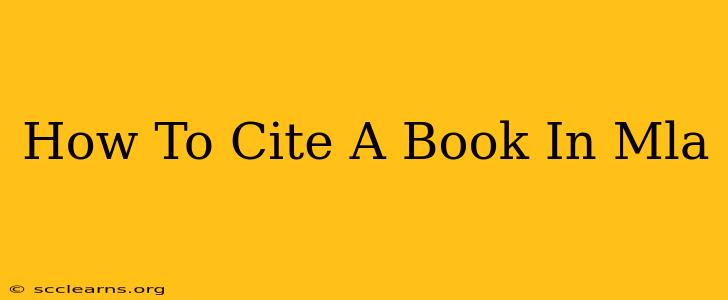Citing sources correctly is crucial for academic integrity. MLA (Modern Language Association) style is widely used in humanities disciplines, and knowing how to cite a book in MLA format is a fundamental skill for students and researchers. This guide provides a clear and concise explanation, covering various scenarios and offering tips for accuracy.
Understanding MLA Book Citations
The core of an MLA book citation includes key information: author's name, book title, publisher, and publication date. The format prioritizes clarity and consistency. Let's break down the essential elements:
Essential Elements of an MLA Book Citation
-
Author's Name: List the author's last name followed by a comma and their first name (or initials). If there are multiple authors, list them in the order they appear on the title page, separated by commas. Use an ampersand (&) before the last author's name. For example: Smith, John; Jones, Jane; and Doe, Richard.
-
Book Title: Italicize the title of the book. This distinguishes it from shorter works like articles or chapters. Capitalize all major words in the title and subtitle.
-
Publisher: Include the name of the publishing company. Abbreviate words like "Company," "Inc.," and "Publishers" where appropriate (e.g., "Co.," "Inc.").
-
Publication Date: Use the year of publication. If there are multiple publication dates (e.g., different editions), use the most recent one.
Basic MLA Book Citation Format
The basic format follows this structure:
Author's Last Name, Author's First Name. Title of Book. Publisher, Publication Year.
Example:
Smith, John. The History of Clocks. Acme Publishers, 2023.
Handling Different Scenarios
Not all books follow a standard format. Here are some common variations and how to handle them:
Books with Editors
If the book is edited, use "Ed." or "Eds." after the editor's name(s).
Example:
Jones, Jane, ed. Essays on Time. Galaxy Press, 2022.
Books with Multiple Authors
List multiple authors in the order they appear on the title page, separating them with commas and using an ampersand (&) before the final author.
Example:
Smith, John; Doe, Richard; & Brown, Mary. The Art of Clockmaking. Zenith Books, 2021.
Books with No Author
If the book has no author, begin the citation with the title.
Example:
The Oxford English Dictionary. Oxford University Press, 2019.
E-books and Online Books
For e-books, add the platform (e.g., Kindle, Google Books) and any relevant URL after the publication information, if possible. If a DOI (Digital Object Identifier) is available, use it instead of a URL. DOIs are usually more stable than URLs.
Example:
Smith, John. Digital Time. Kindle ed., Amazon, 2024.
Translations
If citing a translated work, include the translator's name after the title, preceded by "Trans."
Example:
Du Bois, W.E.B. The Souls of Black Folk. Translated by David Levering Lewis. Oxford University Press, 2023.
Integrating Citations into Your Work
MLA style requires in-text citations alongside your bibliography. In-text citations usually consist of the author's last name and the page number in parentheses.
Example: (Smith 12).
Why Accurate Citation Matters
Using MLA format correctly demonstrates your understanding of academic integrity. It gives credit to the authors whose work you've used and helps your readers verify your sources. Inaccurate citations can lead to accusations of plagiarism, which can have serious consequences.
Resources and Further Help
For the most up-to-date information and detailed guidelines, always consult the official MLA Handbook. Many universities and colleges also have writing centers and online resources that can offer further assistance with MLA citation.
This guide provides a solid foundation for citing books in MLA format. Remember to always double-check your work for accuracy. Correctly citing your sources enhances your credibility and ensures the ethical use of other people's work.

